Converged Devices >> Waiting on the Wave
- By Joseph C. Panettieri
- 03/01/07
Are you prepared to handle the information needs of the next wave of college students? Start planning now, to prevent a tsunami of mobile devices from overwhelming your wireless networks.
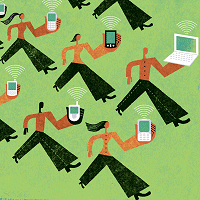 Ash Dyer is building the ultimate digital playground for college
students and residents in Cambridge, MA. As a researcher for
MIT’s Project Airnet, Dyer this year is helping to deploy a citywide
wireless mesh network that will be free for all Cambridge
residents and students. But the Cambridge network
isn’t the only one of its kind. Across the country, universities are helping
towns and cities deploy public broadband systems that will ultimately
serve millions of students, residents, and businesses. Eager proponents
of these broadband WiFi systems include such schools as Ball State
University (IN) and Case Western Reserve University (OH). As each
new public broadband network comes online, it paves the way for new
types of mobile devices to hop on to the internet. It also sets the stage for
universities to rework their existing applications for mobile access.
Ash Dyer is building the ultimate digital playground for college
students and residents in Cambridge, MA. As a researcher for
MIT’s Project Airnet, Dyer this year is helping to deploy a citywide
wireless mesh network that will be free for all Cambridge
residents and students. But the Cambridge network
isn’t the only one of its kind. Across the country, universities are helping
towns and cities deploy public broadband systems that will ultimately
serve millions of students, residents, and businesses. Eager proponents
of these broadband WiFi systems include such schools as Ball State
University (IN) and Case Western Reserve University (OH). As each
new public broadband network comes online, it paves the way for new
types of mobile devices to hop on to the internet. It also sets the stage for
universities to rework their existing applications for mobile access.
“Potentially, any server-based function
can be reformatted for small-screen
display and touchpad interaction,”
asserts H. O’Neal Smitherman, vice
president for information technology
and CIO at Ball State. “Even such functions
as class cancellations through
Blackboard are
possible.”
What a boon for students; they simply
crave that type of mobile power—and a
whole lot more. Today, more than half
of Harvard Medical School (MA) students
carry personal digital assistants
(PDAs) such as iPods, Palm handhelds,
Pocket PCs, and smart phone devices,
according to a recent survey by Harvard
Medical School (see charts in this article). And nearly 20 percent
of the survey participants say they’re
eager to hear class lectures as podcasts,
and to view lectures as digital videos on
their portable devices.
Yet despite such lofty goals, it’s
important to remember that the mobile
revolution remains in its early stages.
For instance, only 5 percent of students
use their PDAs and cell phones for
e-mail services, according to Harvard’s
survey results.
Vendors are feverishly working to develop
new capabilities for mobile phones.
Still, there’s growing evidence that
students want to trade in their laptops
for smaller mobile devices. According
to focus groups conducted by Wireless Harlem, a
nonprofit public broadband advocate
in New York City, most people ages 16
to 30 want laptop-type functionality
squeezed into their smart phones.
“Wireless Harlem also found that this
age group wasn’t swayed by advertisements,
but relied much more on word of
mouth,” says Dyer. “Therefore, if you
see something adopted by a group of
students, you can expect it to become
somewhat of an epidemic.”
The Road Ahead: Dual Mode
University CIOs and their municipal
counterparts will need to ensure that
broadband systems provide plenty of
bandwidth for hundreds of different
devices used by thousands—and perhaps
even millions—of users. Some
university WiFi networks are already
clogged with too many users. Moreover,
universities must somehow provide
wireless network access while safeguarding
student privacy.
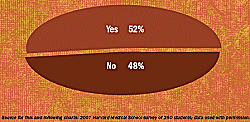
Do You Own a PDA? Students may be better primed
than you thought for expanded mobile data delivery.
Above, the percentage of Harvard Medical School
students owning a personal digital assistant.
Not surprisingly, many colleges are
testing endpoint security solutions and
next-generation encryption technologies.
Among the most promising offerings
is identity-based encryption (IBE),
which uses e-mail information to protect
user identities; Voltage Security and several other
start-ups are working overtime to popularize
IBE.
To be sure, tomorrow’s college campuses
will be filled with converged
devices that allow students to easily
roam between cellular networks, WiFi
networks, and other types of broadband
systems. The rise of so-called dualmode
phones—which move seamlessly
between cellular and WiFi networks—
appears inevitable. Worldwide shipments
of dual-mode handsets are
expected to skyrocket from a few hundred
thousand units this year to 300 million
units in 2011, according to market
research firm ABI Research.
In fact, dozens of companies—from
Apple to T-Mobile USA—are exploring
opportunities in the dual-mode sector.
A typical dual-mode phone will
contain a GSM/CDMA/W-CDMA cellular
radio and an IEEE 802.11 (WiFi) radio, notes Wikipedia. Not to be slow out of the gate, in
October 2006, T-Mobile launched one of
North America’s first dual-mode phone
services. It uses unlicensed mobile
access (UMA), a standard that allows
cellular calls to seamlessly hop to voice
over WiFi (VoWiFi) hotspots. The big
benefit: Students who adopt dual-mode
phones will reduce their need for monthly
cellular minutes by placing some calls
over WiFi connections. The T-Mobile
service supports the Nokia 6136 and Samsung T709 devices. Each costs $50
with a two-year contract and a voice plan
starting at $39.99 per month.
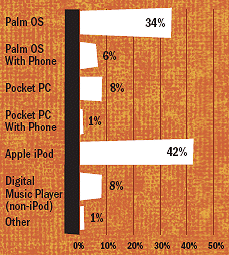
If You Own a PDA, Which Kind? Harvard medical
students go for iPods and Palms. Which converged
devices will your students favor?
“Dual-mode wireless phones will
become significant devices on the college
campus for two major reasons,”
says Ball State’s Smitherman. “First,
with WiFi as well as cellular speeds, the
platform potentially enables a wide array
of functions that are not possible at traditional
cellular speeds. Second, vendors
and institutions are feverishly working to
develop new capabilities for phones, as
well as port existing capabilities to phone
platforms.”
Despite recent momentum, however,
dual-mode phones have suffered from
several false starts. In mid-2006, Cisco Systems and Motorola scrapped plans to
jointly build a dual-mode phone because
the device, by design, would only work
with Cisco’s back-end networks.
“It would have been akin to making a
PC that only works with Cisco’s networks
but nobody else’s,” says tech consultant
Ed Golod, president of New York-based
Revenue Accelerators. “That approach would
have been suicide. It would have severely
limited the device’s popularity.”
7 Companies Worth Watching
Apple Unveiled iPhone in January and plans
to ship the dual-mode device in June.
Currently locked in a lawsuit over the
iPhone name with Cisco Systems (see
listing below).
Aruba Networks
Developing Mobile Voice Continuity software
that supports call handoffs between WLAN and
cellular networks.
Cisco Systems Scrapped a dual-mode phone project with
Motorola in 2006;
now developing numerous devices on its own.
Linksys subsidiary also has
announced its first dual-mode devices.
Netgear Introduced its first dual-mode devices
supporting traditional phone services and
Skype (see listing below).
Nokia 6136 UMA device can switch seamlessly
between GSM and WLAN.
Skype
Launching WiFi-only handsets, manufactured
by Belkin International, Edge-Core, Netgear, and SMC Networks.
Symbol Technologies
Acquired by Motorola in January, Symbol is
developing a wireless switch that manages
handoffs of dual-mode phone calls. The product
is slated to ship in Q2 2007.
Today, Cisco and Motorola each are
designing dual-mode phones that interoperate
with all types of WiFi networks.
In December, the Linksys division of Cisco announced
iPhone—a family of dual-mode phones
that support traditional phone lines and
VoIP services. Students can, for instance,
use the phones to access Skype or standard phone lines. It’s
unclear if or when Linksys plans to add
cellular support.
Opportunity Rings for Apple
Of course, Linksys isn’t the only company
developing an “iPhone” device. Apple
made worldwide headlines when it
launched a dual-mode phone under the
“iPhone” moniker during the Macworld Expo in January.
(Apple and Cisco are currently
embroiled in litigation over the iPhone
name.) Apple has been studying the converged
phone market for several years,
and in 2005 tested the mobile phone market.
A partnership that year with Cingular and Motorola
generated an iTunes-compatible cell
phone, but frustrated students couldn’t
buy music directly via the phone and the
device never gained widespread popularity.
Throughout 2006, the web buzzed
with rumors that Apple was developing a
dual-mode phone on its own. But the
rumors remained unsubstantiated until
Apple CEO Steve Jobs finally unveiled
the iPhone.
“I think Apple really took its time
evaluating this market,” says Jonathan
Mendelson, director of business development
for devices at CA-based BoingoWireless. “You have
to consider such variables as battery
life. And Apple also had to consider
how a mobile phone would manage
downloads in the field. I think it’s clear
that they didn’t want to launch a product
before it was ready for prime time.”
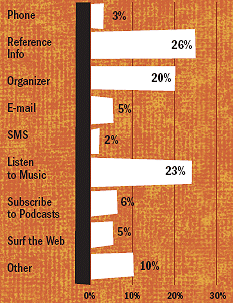
How Do You Use Your PDA? Information, please!
It’s not just for appointments anymore...
Will Apple’s iPhone catch on with a
new generation of college students?
MIT’s Dyer thinks the iPhone will only
appeal to deep-pocketed kids who can
afford the device’s starting price of
$499. “The thing about the student population
is that they’re mobility-driven
and fashion-fickle,” he says. “For many
students, cost is a major factor, so they’ll
pick the most inexpensive options. For
others, it’s functionality and applications—
either the coolest thing, or just
what they need for their daily lives.” For
example, he notes, international students
like T-Mobile devices because they can
send instant messages to Europe with no
additional charges.
Making Roaming a Reality
Another big stumbling point for today’s
wireless devices involves roaming.
Many dual-mode phones, for instance,
can’t easily roam between cellular and
WiFi services. Here again, progressive
universities are striving to save the day.
MIT’s Living the Future project, for
one, is creating Amulet: a combination
personal router and personal information
manager that has built-in radios for
many communication methods (WiFi,
WiMAX, cellular, etc.). “Basically, you
can roam from network to network without
ever noticing it,” says MIT’s Dyer.
6 Considerations for Dual-Mode Success
Thinking about a dual-mode rollout on your own campus? Here’s what you need to know, in a nutshell.
- Customer buys a dual-mode phone and
connects a special WiFi router to a broadband
connection (DSL, cable, etc.).
- Phone automatically recognizes local
home, dorm, office, or commercial hotspots.
- When the phone is in range of the WiFi
network, it seamlessly routes any cellular
calls through the WiFi network and onto the
internet.
- If the transfer is seamless, the caller will
not notice any difference during the switch
between networks, and his cellular minutes
will not add up while on the WiFi network.
- The whole operation can be controlled by a
mobile carrier or worked in conjunction with
an established internet telephone provider.
- Eventually, services for dual-mode devices
can be expanded to leverage public WiFi
hotspots or citywide wireless deployments.
Source: SFGate.com
Similarly, Boingo has developed an
online service that allows students to
roam seamlessly between retail hotspot
locations. The company also is designing
open source software that cell phone
companies and mobile device makers
can embed in their products. Eager
adopters include Belkin International, which embraced
Boingo’s software and designed a WiFi
device that allows students to roam
between commercial hot spots.
Instead of hitching its wagon to a
single operating system, Boingo’s open
source software runs on the vast majority
of mobile platforms,
including Qualcomm’s BREW (Binary Runtime Environment for Wireless),
Linux , and Microsoft’s Windows Mobile
2003 and Windows Mobile 5.0 versions,
with support for other operating systems
set to debut this year.
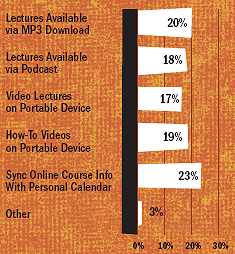
Which Types of Mobile Apps Would Most
Improve
Your Educational Experience?
Answer: Anything you've got!
Despite these dual-mode advancements,
skeptics remain. “I’m a bit dubious
about the adoption of dual-mode
phones by students,” says Dyer. “Their
adoption is driven by a small set of
applications.” And in truth, when it
comes to mobile applications, students
are most interested in social networking
and streaming music/video. “The only
way dual-modes will catch on,” he adds,
“is if students realize the new devices
can deliver those applications so much
better than their current service.”
Instead of focusing on bandwidth-intensive
video applications, universities
might be wise to start slowly with
mobile applications that deliver simple
—but highly valuable—calendaring and
scheduling capabilities.
Concludes Ball State’s Smitherman: “How much would a student appreciate
a message on his ever-present communication
device, indicating that a class
has been cancelled?
There
would be no
need to leave
a warm, cozy
bed, only to
trek through the snow to a class with a
cancellation note on the door.”
Ah, to sleep, perchance to dream. Anything’s
possible with today’s mobile
devices.
WEBEXTRA :: Learn about other schools ahead of the curve with mobile devices:
click here.